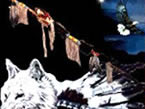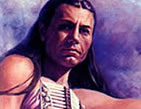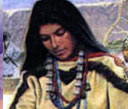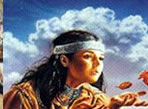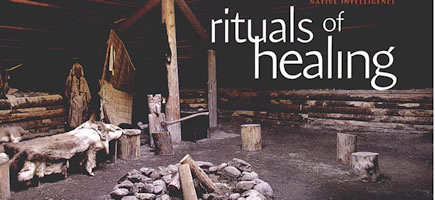"For
a Native American, a healing is a spiritual journey," declares
Lewis Mehl-Madrona, M.D., author of Coyote Medicine and a descendent
of the Lakota and Cherokee tribes. "What happens to the
body reflects what is happening in the mind and spirit."
The integration of the physical
and the spiritual is at the heart of the tradition of sweat
lodges, a Native American ceremony believed to be the most
widely practiced indigenous healing ritual. "For us, it's
sort of like going to church, something to practice on a regular
basis," says Mehl-Madrona, research
coordinator for the program of integrative medicine at the University
of Arizona in Tucson. A sweat can be used as its own ceremony,
to cleanse oneself and reconnect with Mother Earth, or as preparation
for other important undertakings, such as the Vision Quest or the
Sun Dance.
The sweat lodge
is a place of magic and visions, but it is also physically
taxing. Drink plenty of water on the day of a swat. Eat
lightly, wear loose, lightweight clothing.
| Herbs are often used in
ceremonies. At some sweat lodges, sage and cedar are
thought to purify the space (and the participants)
while tobacco leaves bless the earth. "Because
it's plentiful around here, I sometimes use eucalyptus.
too," says Edward Albert, whose backyeard sweat
lodge is a place for family to gather. |
The particulars of the rituals vary from
tribe to tribe and from family to family, says Mehl-Madrona.
Yet the central concept is always to purify body, mind and
soul through intense heat generated by pouring water over hot
rocks. Some form of this ancient practice is found in cultures
around the world, from the Finnish sauna to the Russian bania,
and from the Jewish shvitz to the Turkish hamman.
"You're essentially
generating a fever in the body," Mehl-Madrona explains.
The physical benefits of this have been enumerated in study
after study, he says. A body temperature of 102 to 106 degrees
("which is what we suspect is generated in a sweat lodge")
creates a hostile environment for bacterial and viral infection. Sweating flushes toxic metals,
such as copper, lead and mercury, and removes excess salt,
a benefit for those with mild hypertension. The heat and sweating
also helps ease soreness and stiffness, and dilates capillaries,
increasing blood flow to the skin. Mehl-Madrona participates
in sweat-lodge ceremonies with Native American patients and
others who feel they might benefit, but the physical rewards
are only one small reason. A sweat lodge can't be separated
from its context as a spiritual ritual or it loses its power. "If you just want to
feel better sweating, go take a sauna, but don't call it a
sweat," he insists. "Healing comes on a spiritual
level. We have to make ourselves available to the spiritual
realm. Ceremony and ritual provide the means of making ourselves
available." ceremony
and song Almost every aspect of a
sweat lodge has a symbolic meaning, says Edward Albert, the
California state commissioner for Native American lands. Lodges
are usually round or oval, reflecting the shape of the womb,
and the experience is likened to being reborn in healing energy.
The flap or door of a lodge is generally built very low, forcing
people to enter crouched or even on their knees as a show of
humility and respect for the earth as a sacred, living entity. Although construction varies,
numerous tribes prefer willow, which has long been used medicinally
(its bark contains salicin, the analgesic in aspirin compounds);
it's known as the "tree of love" in the Seneca tradition,
due to its resilience and grace. Since willow dies in the winter
and comes up again in spring, it also offers a lesson in death
and rebirth. Saplings are set up to represent
four quadrants, signifying the four elements and the four directions.
Originally, lodges were covered with animal skins; contemporary
structures use blankets or tarpaulins. A fire pit just outside
the lodge is used to heat rocks, called the Stone People, which
represent one's elders. When the rocks are thoroughly heated,
they are brought into the tent in a series of four rounds (or
sometimes 16 or 32 rounds). Then water is poured on the stones,
generating steam, which symbolizes, in part, the release of
ancient knowledge.
A sweat begins in total silence-sometimes
thought of as the "true voice of the Creator"-but
songs, prayers, chants and heartfelt talk are central to most
ceremonies. Sweats can last for days at a time in traditional
settings, but for the newly initiated a two-hour series of
rounds provides a complete experience.
Though generally considered
safe, says Mehl-Madrona, the excessive sweating produced in
a lodge isn't for everyone, because it can adversely interact
with medication or exacerbate certain conditions. Pregnant
women, people with heart disease, and anyone taking benzodiazepines
(Xanax, Valium) should check with their physicians before participating
in a sweat lodge ceremony.
Others who should proceed
with caution are very overweight and very underweight people,
who have an equally difficult time regulating body temperature
and are more likely to faint in excessive heat. And those who
suffer from claustrophobia and post-traumatic stress disorders
can have their conditions triggered by the dark, closed space
of a lodge.

|
